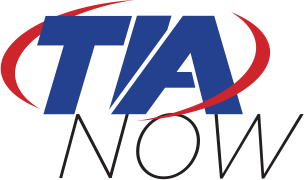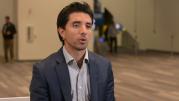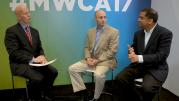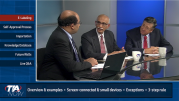TIA NOW
Featured Video
-
What will define 5G is coming into focus. The need for an effective standards process, that will represent the varied stakeholders, is critical. TIA NOW discusses this process and shows a working demo of 3 future capabilities of 5G.
All TIA NOW Videos:
-
With Corning's acquisition of SpiderCloud, they are focused on helping enterprises with their communications strategies. Bill Cune, Vice President of Wireless Market Development of Corning discusses SpiderCloud, its integration with the Corning ONE system, and how the two are driving robust communications in the enterprise as well as large public venues.
-
5G networks promise efficient, fast connectivity to usher in a new era of services for consumers and businesses. However, deployment is dependent on clear, fair zoning to make 5G a reality. Brian Hendricks, Head of Policy and Government Affairs at Nokia and Dileep Srihari, Director, Legislative and Government Affairs at TIA discuss securing edge network presence in preparation for 5G rollouts.
-
Zup Co-Founder Felipe Almeida sits down with TIA’s John Jacobs to discuss the need of service providers and financial institutions to turn up customers with fully integrated, secured cloud services to better compete and drive deeper relationships.
-
The need to create smarter businesses through the deployment of new technologies requires more efficient and better connected buildings in which to house those businesses. Here to discuss the latest developments of planning and construction of smart buildings - and the federal government’s role in helping - are Maria Vargas, Director of the U.S. Department of Energy’s Better Buildings Initiative and Eric Hall, Chief Innovation Officer of Site 1001, a spinoff of JE Dunn Construction.
-
Spirent’s Dave Garrison and Rajat Agarwal reveal how 5G is more than a generational improvement on 4G; it's a new way to design and build networks from core to edge to RF. 5G will require a re-think of the role of networks in meeting end user demands.
-
The TIA-942 data center cabling standard was recently updated with the release of 942-B, which includes a lot of important changes. John Jacobs, VP of Market Intelligence and Research at TIA, spoke with Jonathan Jew, President of J&M Consultants and Secretary of TIA’s TR-42 Cabling Systems Engineering Committee, about this update and why it's critical for those who build and manage data centers.
-
Accelerating the development and adoption of NFV requires working with service providers and ecosystem partners to help build deployable solutions. But what barriers still exist that prevent virtualized networks from being deployed everywhere today? Timon Sloane, VP of Standards and Membership at the Open Networking Foundation, shared his advice on navigating the complexity of NFV adoption and how industry can benefit from open source platforms.
-
On July 13, the FCC updated its Equipment Authorization rules to provide flexibility to manufacturers to use electronic labeling in lieu of a physical label or nameplate, and took steps to streamline the certification process for telecommunications equipment and devices imported into the United States. Julius Knapp, Chief of the FCC’s Office of Engineering Technology and Rashmi Doshi, Chief of the FCC’s Office of Engineering Technology Laboratory Division, dive into the agency's new e-labeling and device certification rules, and explain how it will benefit regulators, manufacturers, and consumers alike.
-
The big data and data science revolution is upon us as firms are currently spending an estimated $36 billion on storage and infrastructure, that will double the data mining sector by 2020. Here with us in the TIA NOW studio to talk about predictive analytics is Richard Boire, SVP of Environics Analytics.
-
Two experts talk with TIA about how to negotiate a deal that will expand U.S. tech jobs. TIA’s K.C. Swanson speaks with Brownstein Hyatt’s Barry Jackson, former chief of staff to former House Speaker John Boehner, and Jen Sanford, Director of International Trade and Energy Policy at Cisco. They offer up thoughts on the outlook for modernizing NAFTA on a short timeline, what’s needed for an update, and why improving the deal matters for high-wage American jobs.
-
If you haven’t heard about millimeter-wave technology, you weren’t listening. High frequency bands that allow for multi-use applications in public safety are already in the test phase. Aditya Dhananjay, Post-Doctoral Fellow at NYU's research center, NYU WIRELESS, spoke with Abe Nejad about why millimeter-wave technology for public safety communications is less understood and what unique challenges it presents.
-
5G antenna design will be vastly different as we transition from 4G to 5G. From the interface between the antenna and the radio frequency front end, the use of arrays instead of single antennas and the use of beam steering, just how different will it be? Here to tell us is James Kimery, Director of Product Marketing for RF Communications and Software-Defined Radio at National Instruments.
-
Analysts from IDC including spoke with TIA NOW about the tough issues that the communications technology industry is currently tackling, which were covered at the TIA Connectivity Jam in Dallas, TX. These issues span from data management, edge computing, connected devices, network benchmarking and artificial intelligence.
-
Carl Rivkin, Manager of Safety Codes and Standards at the National Renewable Energy Laboratory (NREL), spoke with TIA NOW about how fuel cells act as reliable back-up power for cell towers. Rivkin focused on the environmental, safety and connectivity benefits of fuel cell technologies.
-
Gary Bolton, VP of Global Marketing at ADTRAN, spoke with TIA NOW about how the value of networks is based on the number of users of a platform. Bolton goes on to say that being able to match producers with consumers is the key to a successful platform economy.















